Looking for ways to reduce the cost of your tech stack?
There are many reasons why software costs can begin to creep up, from shadow IT to organizational siloes.
If you don’t already have a process in place to manage and reduce software costs, you could save a decent chunk of your IT budget by following the guidance in this article.
Software cost reduction is an ongoing process, so we’re also going to show you how to set yourself up to reduce your software costs and keep them low.
Even if you don’t feel a pressing need to reduce your software costs, you may want to seriously consider deploying these strategies anyway.
It’s no secret that businesses may soon be facing headwinds if they aren’t already.
“IT sourcing, procurement, and vendor management (SPVM) leaders must take immediate action to alleviate financial pressure for a six- to 24-month period,” says Gartner Senior Director Analyst Stephen White late last year. “Leaders need to protect their organizations from financial disruption and build resilience for what may yet be to come.”
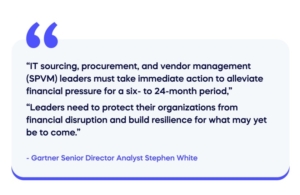
With the practical advice in this article, you’ll be well-equipped to protect your business from potential financial disruption and learn how to keep the cost of your tech stack lean and low— directly benefitting your bottom line.
Gartner’s top strategy for software cost reduction? Vendor negotiation
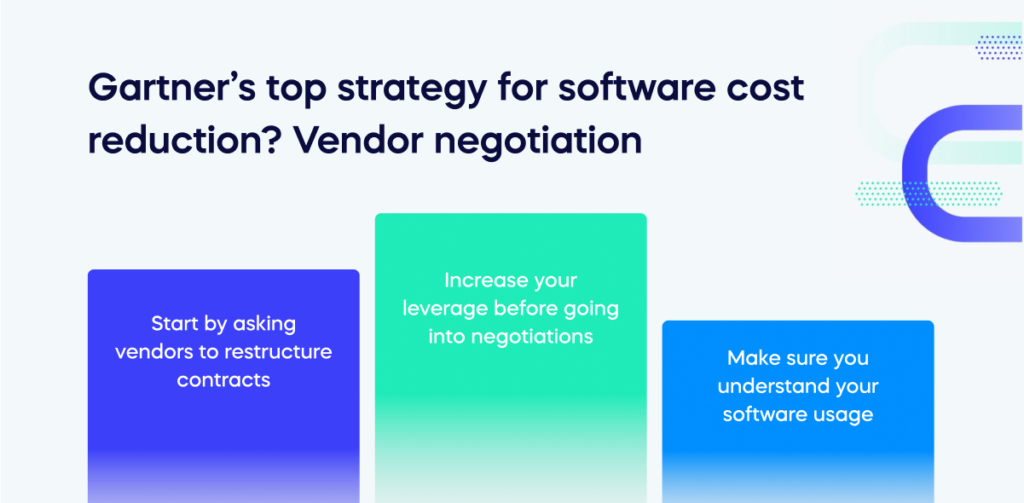
It pays to learn from the experts, and Gartner has written about their top 3 strategies to cut software and cloud costs.
Gartner’s approach centers on negotiating better prices from your existing software vendors.
This is an excellent strategy because you can increase your profitability without necessarily increasing your customer base or cutting down your tech stack. There’s not really a downside to doing this.
Negotiating better terms and prices with your existing vendors can significantly improve your business’s bottom line and free up resources that can be better invested in other areas of the enterprise.
The catch is it’s not easy.
Negotiating with vendors requires the right strategy, approach, and communication skills to achieve the desired outcome.
In this regard, it’s essential to understand your business’s needs, establish a rapport with your vendors, and leverage your buying power to negotiate better deals.
Let’s drill down into some strategies to help you create a win-win situation with your vendors that improves your business’s financial health.
Start by asking vendors to restructure contracts
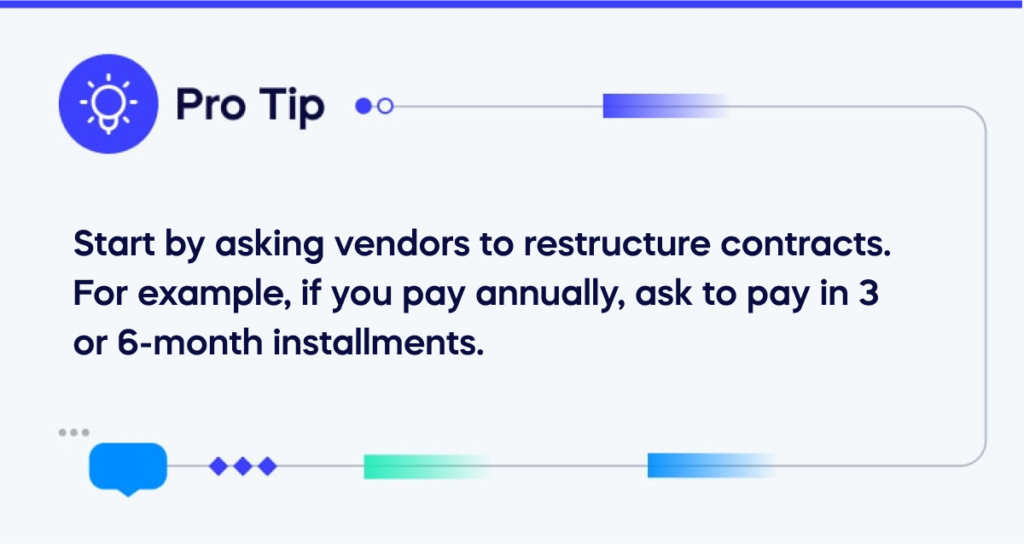
The first thing you should do is talk to your vendors.
Tell them you’re looking for ways to improve your financial health but that you value your relationship with them.
Begin by asking them to restructure contract terms.
For example, if you pay annually, ask to pay in 3 or 6-month installments.
This opens the door to further conversations and sets the expectation for change. It helps you get off on the right foot and launch your negotiations.
Make sure you understand your software usage
Take stock of IT assets, review contracts, and analyze usage data to understand what’s being used—or not.
Once you know what’s not being utilized, you can decide whether to terminate services or renegotiate contracts.
This is a great way to free up resources that could be better invested in other business areas.
Ensuring you have adequate visibility into all software assets and users will help ensure your organization is not paying for unnecessary services or applications.
It will also give you valuable data for vendor negotiations— you’ll know what you need and what to ask for.
In any case, it’s good practice to regularly carry out a digital audit of your software licenses and subscriptions for cost savings opportunities and to ensure compliance with industry regulations.
Increase your leverage before going into negotiations
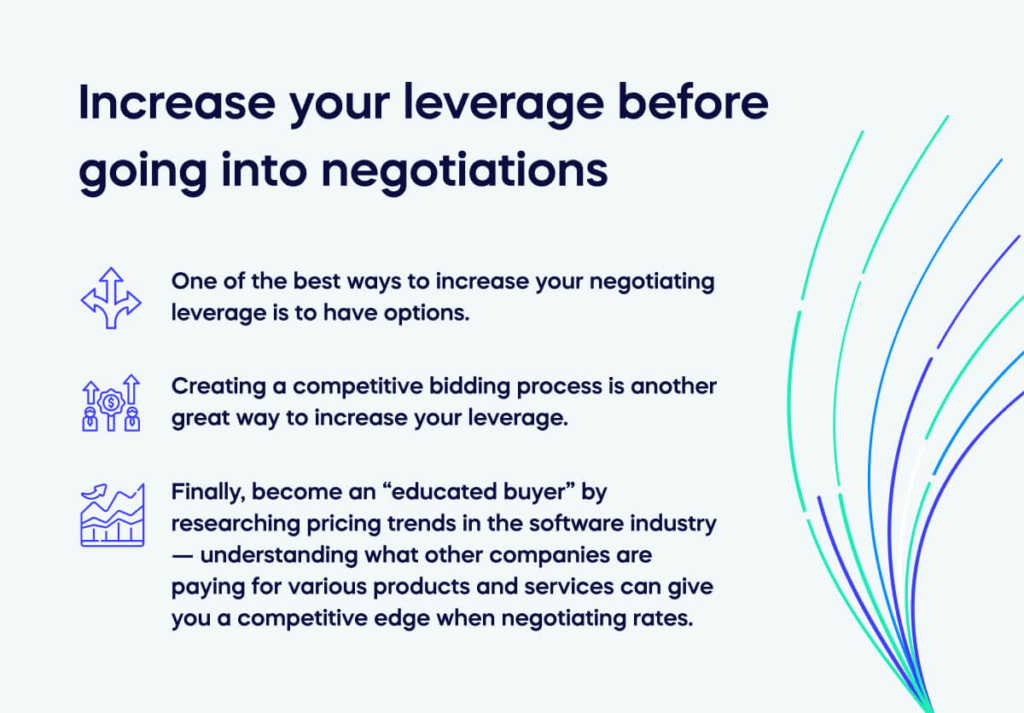
By increasing your leverage before going into negotiations, you’ll be in a much stronger position to get the best deal possible for your organization.
One of the best ways to increase your negotiating leverage is to have options.
If you’re locked into a current vendor, shop for an alternative offering better terms or pricing.
Creating a competitive bidding process is another great way to increase your leverage.
Invite several vendors to compete for your business by submitting bids and then compare their rates and offerings side-by-side before deciding.
This will help ensure that you get the best deal available in the market, and you can use it as leverage when renegotiating with your existing vendor.
Finally, become an “educated buyer” by researching pricing trends in the software industry— understanding what other companies are paying for various products and services can give you a competitive edge when negotiating rates.
But remember to keep it realistic. A vendor won’t agree to something unless there’s also a benefit to them. It’s on you to ensure they know what they’re getting out of the deal.
Four more software cost-reduction strategies
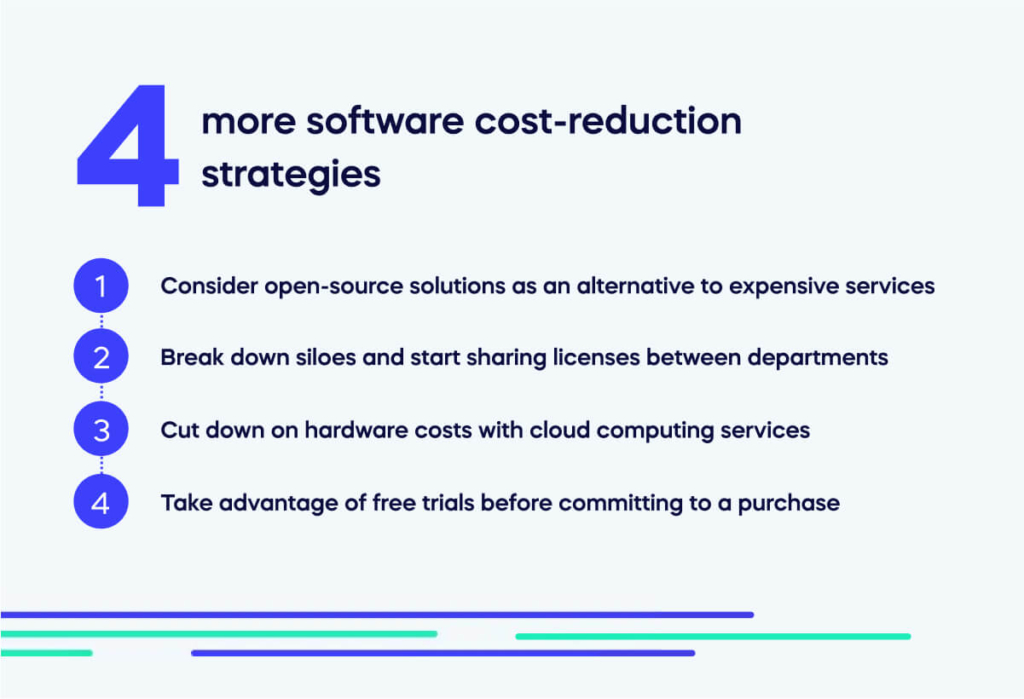
Negotiating with vendors isn’t the only way to reduce the cost of your tech stack.
There are plenty of other ways to tackle this problem. Let’s take a look at a few of the most versatile options:
Consider open-source solutions as an alternative to expensive services
By taking advantage of the open-source community, you can access a wealth of resources ranging from software, documentation, and user communities.
These solutions are often just as robust as proprietary software, if not more so.
Furthermore, open-source solutions provide higher transparency, allowing for greater customization and optimization.
In short, open-source solutions offer companies an affordable and flexible alternative to expensive services.
The downside is that you don’t get the same customer success support or technical help.
Break down siloes and start sharing licenses between departments
One effective way to reduce organizational costs is to break down organizational siloes.
Often different departments have similar software requirements but don’t know it. The business ends up paying more just because they don’t want to mix up budgets between different departments.
By breaking down those organizational siloes, you encourage different departments to collaborate and pool resources instead of each team investing in separate licenses for the same software or application.
By sharing licenses, you can reduce their overall expenses and streamline their operations, resulting in significant cost savings.
Additionally, this approach encourages better communication between departments and promotes a culture of resourcefulness and efficiency.
As a by-product, you’ll also boost collaboration and allow different departments to learn from one another.
Cut down on hardware costs with cloud computing services
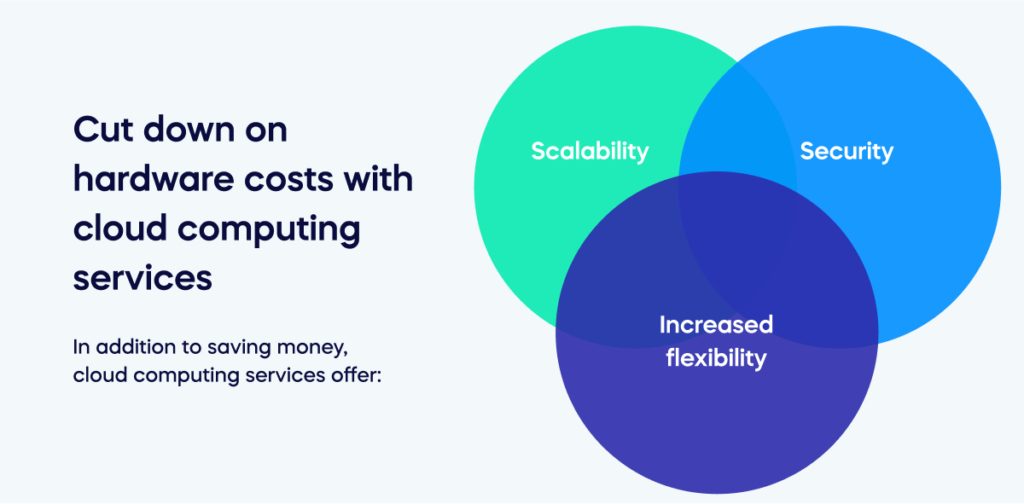
Cloud computing services have become increasingly popular in recent years because they allow you to cut down on hardware costs.
By using cloud computing, you can reduce the need for expensive hardware installations and maintenance.
In addition to saving money, cloud computing services offer increased flexibility, scalability, and security.
With cloud computing services, you can easily scale your resources up or down as needed, reducing waste and maximizing efficiency.
Furthermore, cloud computing services offer advanced security measures that can help protect against cyber threats and data breaches.
They can be more expensive on paper, but cloud services can work out cheaper in the long run than on-premise solutions.
Take advantage of free trials before committing to a purchase
As a savvy consumer, it’s important to make informed decisions when purchasing anything.
The same advice holds true for a savvy business leader.
Many companies offer free trials to allow you to test out their offerings before committing to a purchase.
By taking advantage of these opportunities, you can get a firsthand look at the features and functionality of different software programs to determine which one best fits your needs.
Not only does this save you money, but it also ensures you select the right software for your specific situation.
So, next time you’re in the market for new software, explore free trial options to make the most informed decision possible.
Four ways to model your software costs
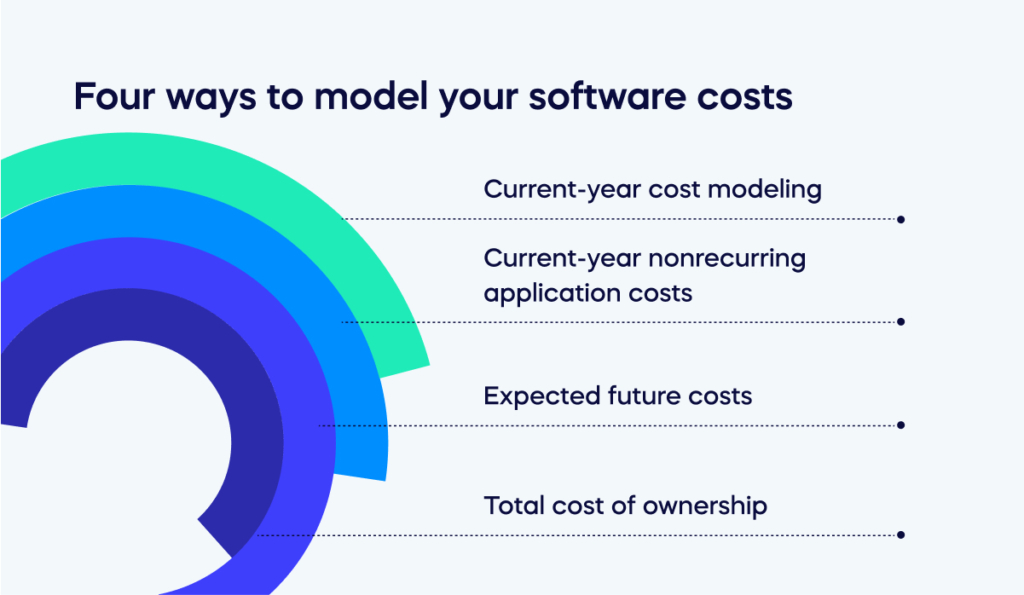
Before you can make any major decisions about your tech stack, you need to understand:
- What software you’re using
- How you’re using it
- Why it’s necessary
At the least.
These four tools can help you decide how to model your software costs. Once you’ve done that, you’ll be in a great position to implement some software cost-reduction strategies.
Current-year cost modeling
Current-year cost modeling is a strategy that evaluates the cost of a product or service based on present market prices.
It considers real-time variables such as inflation, supply chain dynamics, and market demand to provide a more accurate cost estimation.
This approach is more dynamic than historical cost modeling, which relies on past prices, potentially making it less accurate under changing economic conditions.
Current-year nonrecurring application costs
Current-year nonrecurring application costs refer to one-time costs associated with specific software or applications during a particular year.
These might include costs for setup, implementation, or special customization of software, which aren’t expected to occur regularly or regularly.
For instance, if you decide to implement a new customer relationship management (CRM) system, you might incur nonrecurring costs for initial software licensing, setting up the system, delivering employee training, or customizing the system to meet your unique needs.
These costs are tied to that specific year and aren’t expected to recur in the following years.
Expected future costs
This refers to the anticipated expenses related to the future acquisition, development, maintenance, and upgrade of software systems.
These costs can significantly impact your IT budget, so keeping tabs on them is important.
For example, when you plan to implement new software, you must consider immediate costs like licensing and implementation costs.
But the spending doesn’t stop there. Future costs such as maintenance fees, upgrade costs, user training, and potential downtime during upgrades must also be accounted for.
Total cost of ownership
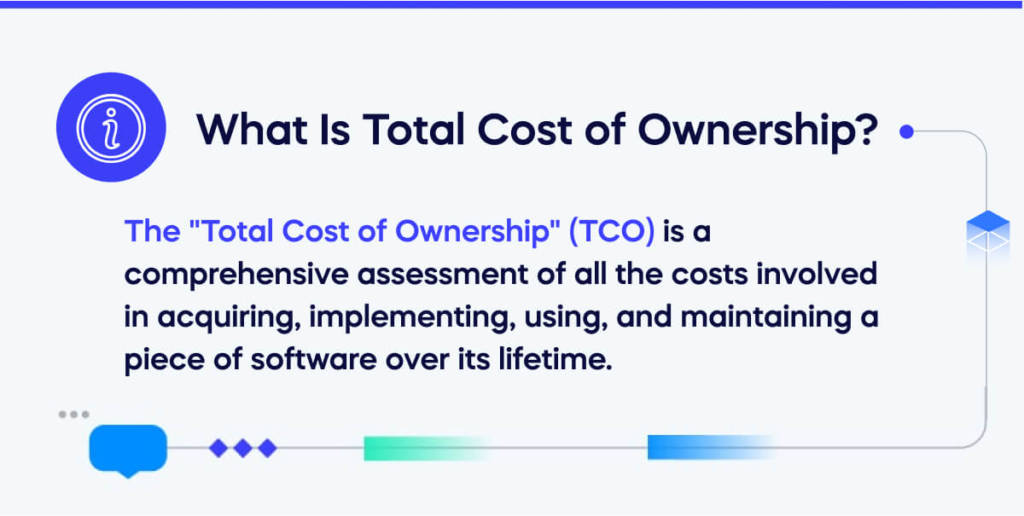
The “Total Cost of Ownership” (TCO) is a comprehensive assessment of all the costs involved in acquiring, implementing, using, and maintaining a piece of software over its lifetime.
It provides a complete picture of a software investment beyond the initial purchase price.
TCO includes upfront costs like software licensing or subscription fees, implementation and integration costs, and hardware needed to run the software.
However, it goes much further by considering ongoing costs such as software maintenance, upgrades, user training, and support services.
Eliminate waste and create budget space with software cost reduction
Reducing the cost of your business’s software tech stack is a wise and prudent plan, and the strategies discussed in this article are some of the most effective ways to accomplish it.
According to Gartner, you should focus your efforts on vendor negotiation first and foremost.
But we think you can get massive value from breaking down organizational siloes and exploring open-source options.
These options provide viable ways to reduce your company’s tech stack expenses.
By employing the methods outlined in this article, there’s no limit to the cost savings you can achieve for your business.


